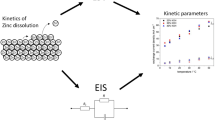Abstract
The following document covers the determination of the diffusion coefficient of two powder materials: LiFePO4 and LiMn2O4 by using potentiostatic intermittent titration technique (PITT) and impedance spectroscopy methodology and compares relevant results with the following relation: \(D = \frac{{R^2 I_0 }}{{3\alpha Q}}\), which is obtained by solving Fick’s spherical coordinate equation (where I 0 is the initial step current in the PITT experiment, R is the particle radius, Q is the charge that intercalated during the step, and α is the percentage of the theoretical intercalated charge). This procedure allowed the verification of the validity of the spherical model for the powder materials, the accuracy of the expression proposed for the diffusion coefficient determination, and the correctness of the measures that had been taken.
















Similar content being viewed by others
References
Wen CJ, Boukamp BA, Huggins RA, Weppner W (1979) J Electrochem Soc 126:2258
Deiss E, Häringer D, Novak P, Haas O (2001) Electrochim Acta 46:4185
Tang XC, Song XW, Shen PZ, Jia DZ (2005) Electrochim Acta 50:5581
Tang XC, Pan CY, He LP, Li LQ, Chen ZZ (2004) Electrochim Acta 49:3113
Deiss E (2002) Electrochim Acta 47:4027
McKinnon WR, Haering RR (1987) Modern aspect in electrochemistry. Plenum, New York
Ho C, Raistrick ID, Huggins RA (1980) J Electrochem Soc 127:343
Bauer EM, Bellitto C, Righini G, Pasquali M, Dell’Era A, Prosini PP (2005) J Power Sources 146:544
Bellitto C, Bauer EM, Righini G, Green MA, Brandford WR, Antonini A, Pasquali M (2004) J Phys Chem Solids 65:29
Antonini A, Bellitto C, Pistoia G (2001) US Patent no. 6274279
Xia Y, Zhou Y, Yoshio M (1997) J Electrochem Soc 144:2593
Robertson AD, Lu SH, Howard WF (1997) J Electrochem Soc 144:3505
Weppner W, Huggins RA (1977) J Electrochem Soc 1569:1578
Levi MD, Levi EA, Aurbach D (1997) J Electroanal Chem 421:89
Srinivasan V, Newman J (2004) J Electrochem Soc 151:A1517
Montella C (2002) J Electroanal Chem 518:61
Montella C (2005) Electrochim Acta 50:3746
Vorotyntsev MA, Levi MD, Aurbach D (2004) J Electroanal Chem 572:299
Brown ER, Sandifer JR (1986) In: Rossiter BW, Hamilton JF (eds) Physical methods of chemistry, 2nd edn. Wiley, New York
Pyun SI, Choi YM, Jeng ID (1997) J Power Sources 68:593
Saїdi MY, Barker J, Koksbang R (1996) J Solid State Chem 122:195
Prosini PP, Zane D, Pasquali M (2001) Electrochim Acta 46:3517
Peňa JS, Soudan P, Arean CO, Palomino GT, Franger S (2006) J Solid State Electrochem 10:1
Pyun SI, Choi YM, Jeng ID (1997) J Power Source 68:593
Prosini PP, Lisi M, Zane D, Pasquali M (2002) Solid State Ionics 148:45
Levi MD, Aurbach D (1999) Electrochim Acta 45:167
Author information
Authors and Affiliations
Corresponding author
Appendix
Appendix
The solution has this form: c(r,t) = X(t)Y(r) + K 1.
X(t) is only t dependent, Y(r) is only r dependent, and K 1 is a constant:
the left side of the Eq. 20 is only a function of the time, while the right side is only a function of the radius. Therefore, both parts have to be constant, and the solution is:
Because this equation must be also valid when r = 0, we impose A = −B, and then assuming C 1 A = C 2, we have:
assuming \(C_2 = \frac{{K_2 }}{{2i}}\) to have a real solution and knowing that
we can write:
\(\sqrt {\frac{K}{D}} R = \lambda \pi \) for λ = 1, \(K = \frac{{\pi ^2 D}}{{R^2 }}\) and therefore:
the boundary conditions are:
so:
Rights and permissions
About this article
Cite this article
Dell’Era, A., Pasquali, M. Comparison between different ways to determine diffusion coefficient and by solving Fick’s equation for spherical coordinates. J Solid State Electrochem 13, 849–859 (2009). https://doi.org/10.1007/s10008-008-0598-z
Received:
Accepted:
Published:
Issue Date:
DOI: https://doi.org/10.1007/s10008-008-0598-z




